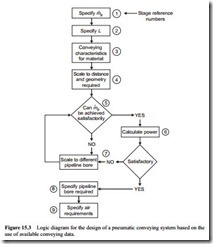The use of test data in system design
The application and use of test data is probably the most common method of designing a pneumatic conveying system. This is used extensively in cases where test data or pre- vious experience with a material is available. Where no previous experience with a particular material is available, it is usual to obtain test data specifically for the purpose of system design, since the use of mathematical models is particularly unreliable in these situations. As for the section on the use of equations in system design, two logic dia- grams are also presented here, one for the original design of a system, and another for evaluating the capability of an existing system.
Related posts:
System and process requirements:Introduction to variable speed concept
Engineering Data:Standards and publications
Vacuum and Low Pressure:Vacuum techniques
First approximation design methods:Working relationships
Erosive wear:Wear of straight pipeline
First approximation design methods:Operating point and Solids loading ratios.
Erosive wear:Influence of variables and Theories proposed.
Operating problems:Vacuum nozzles and Flow control.
Conveying characteristics:Component pressure drop relationships
Hydraulic fluids:General types of fluids.
Hydraulic pumps:Pump performance
INTRODUCTION AND OVERVIE:ACCURACY, PRECISION, AND SIGNIFICANT DIGITS
BASICCONCEPTS OF THE RMODYNAMICS:TEMPERATURE AND THE ZEROTH LAW OF THERMODYNAMICS
PROPERTIES OF PURE SUBSTANCES:THE IDEAL-GAS EQUATION OF STATE
ENTROPY:PROPERTY DIAGRAMS INVOLVING ENTROPY
